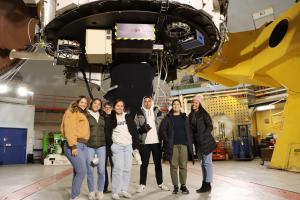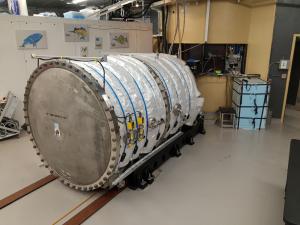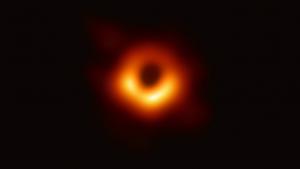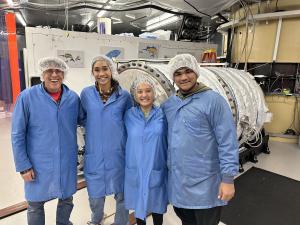Hawaiian language students name new astronomy instrument on Maunakea
University of Hawaiʻi at HiloDigital Media Education Specialist , ʻImiloa Astronomy Center
Moanikeʻala Nabarro , (808) 600-4084
Spokeswoman, UH Communications
Link to video and sound (details below): https://go.hawaii.edu/Fm7
ʻŌlelo Hawaiʻi (Hawaiian language) students on Hawaiʻi Island have named a new instrument at the Canada-France-Hawaiʻi Telescope that will help astronomers study the universe in greater detail. The Hawaiian naming project is part of the A Hua He Inoa program at ʻImiloa Astronomy Center at University of Hawaiʻi at Hilo.
The instrument’s name, Wenaokeao, meaning “earliest glow of light,” was given after extensive research by high school haumāna (students) from Hawaiian medium education school Ke Kula ʻo Nāwahīokalaniʻōpuʻu, who are interns in the A Hua He Inoa program at ʻImiloa. The name describes the soft glow of the rising sun seen during the fleeting moments when the full Moon lowers on the horizon, just before dawn breaks. Students chose the name after they visited CFHT on the summit of Maunakea, and were also advised by Larry Kimura, an associate professor of Hawaiian language and Hawaiian studies at UH Hilo.
“Ua pili kēia mau manaʻo o Wenaokeao i kēia mea ʻo ka ʻōlelo Hawaiʻi ʻoiai ma loko o nā māhele o kēia inoa holokoʻa ʻo Wenaokeao, ʻo ka wena ʻana ʻo ia ka pili ana i nā kala i ʻike ʻia ma ka wā e puka mai ana ka lā. A ʻo ke ao, ʻo ia ka lani holoʻokoʻa a me nā kala a pau, a no laila ua loaʻa mai kēia inoa. He pilina ko ia mau mea ʻelua ʻoiai ma ka mīkini loaʻa kekahi ʻāpana e kilo kikoʻī ai i nā kala o ka hōkū a no laila ua manaʻo ua paʻa loa kēia inoa o Wenaokeao ʻoiai like kona hana i ia pō e like me ka mīkini kilo ʻana i nā kala. No laila ua manaʻo he kūpono no ka waiho ʻana ma kēia manaʻo o ka inoa.”
“(When we dissect the name ‘Wenaokeao’, we look at the Hawaiian words “wena” and “ao.” “Wena” references the colors seen in the morning sunrise. “Ao” is the entire world that we see and all of the colors in it. These combined meanings correlate with the instrument because the instrument helps to observe the colors of light emitting from stars),” said Tinai Liusa, a senior at Ke Kula ʻo Nāwahīokalaniʻōpuʻu.
Planet, magnetic field detection
Previously known as “Vision,” the CFHT project combines existing instruments to expand scientific capabilities. The upgrade will allow astronomers to detect magnetic fields and planets around distant stars in a larger wavelength simultaneously.
“I think it’s a wonderful opportunity for the students to practice cultural naming. It’s an honor for us to participate in the process and then to be gifted a name for this instrument,” said Mary Beth Laychak, director of communications and community engagement at CFHT.
Merging culture, science
The A Hua He Inoa program, led by ʻImiloa, creates a pathway where language and culture are at the core of modern scientific practices, melding Indigenous culture and science locally, nationally and worldwide. Previous naming projects include Pōwehi, the first black hole ever pictured, and ʻOumuamua, the first interstellar object discovered.
“Haʻaheo maoli au i kēia ʻauna A Hua He Inoa no kēia kapa inoa ʻana iā Wenaokeao, he ʻāwili maoli i ka ʻike Hawaiʻi i kēia mea hana kilo hōkū. ʻO ko lākou paʻu nui ʻana ma kēia hana, he hoʻohui maoli ia o ka ʻike ʻōiwi o Hawaiʻi me ka ʻepekema e ʻike ai kākou i ke koʻikoʻi o kēia ʻano ʻike kuʻuna ma ka hoʻokele ʻana i ko kākou kuanaʻike o ka ʻōnaeao.” “(I am really proud of our A Hua He Inoa cohort for their contribution to naming Wenaokeao. Their dedication in this process reflects a harmonious blend of place-based knowledge and scientific exploration, enriching our celestial understanding and underscoring the vital role of our Hawaiian language and perspective in guiding our view of the universe),” said Kuʻulei Bezilla, project planner at A Hua He Inoa.
VIDEO BROLL: (6 minutes 43 seconds)
02:22-04:10 A Hua He Inoa students visit CFHT on Maunakea
04:10-04:27 CFHT staff give students a closer look at the instrument
04:27-05:54 Students ask CFHT staff questions about the instrument
06:03-08:05 At ʻImiloa, students discuss CFHT and Hawaiian naming with Larry Kimura
SOUNDBITES:
Pine Harman/ A Hua He Inoa Intern, UH Hilo ʻImiloa Astronomy Center
(Pronunciation: Pee-nay Har-men)
(13 seconds)
“We were able to ask questions to people who work with those instruments every single day on exactly what the instrument does, its purpose and what makes it different from the other instruments that are already on Maunakea.”
(9 seconds)
“And it’s important not just to come up with the name but to find knowledge of the past from our ancestors to back up the meaning of our name.”
Tinai Liusa/ A Hua He Inoa Intern, UH Hilo ʻImiloa Astronomy Center
(Pronunciation: Tee-nye Loo-we-sah)
SOUNDBITE WITH SUBTITLED TRANSLATION
(38 seconds)
"Ua pili kēia mau manaʻo o Wenaokeao i kēia mea ʻo ka ʻōlelo Hawaiʻi ʻoiai ma loko o nā māhele o kēia inoa holokoʻa ʻo Wenaokeao, ʻo ka wena ʻana ʻo ia ka pili ana i nā kala i ʻike ʻia ma ka wā e puka mai ana ka lā. A ʻo ke ao, ʻo ia ka lani holoʻokoʻa a me nā kala a pau, a no laila ua loaʻa mai kēia inoa. He pilina ko ia mau mea ʻelua ʻoiai ma ka mīkini loaʻa kekahi ʻāpana e kilo kikoʻī ai i nā kala o ka hōkū a no laila ua manaʻo ua paʻa loa kēia inoa o Wenaokeao ʻoiai like kona hana i ia pō e like me ka mīkini kilo ʻana i nā kala. No laila ua manaʻo he kūpono no ka waiho ʻana ma kēia manaʻo o ka inoa."
(Translation) When we dissect the name “Wenaokeao”, we look at the Hawaiian words “wena” and “ao”. “Wena” references the colors seen in the morning sunrise. “Ao” is the entire world that we see and all of the colors in it. These combined meanings correlate with the instrument because the instrument helps to observe the colors of light emitting from stars.
CLEAN SOUNDBITE SAME AS ABOVE WITH NO SUBTITLES
(38 seconds)
Mary Beth Laychak/Director of Communications and Community Engagement, Canada-France-Hawaiʻi Telescope
(Pronunciation: Lay-check)
(13 seconds)
“I think it’s just a wonderful opportunity for the students to practice cultural naming and then for us at the observatories it’s such an honor to be able to be gifted with a name.”




